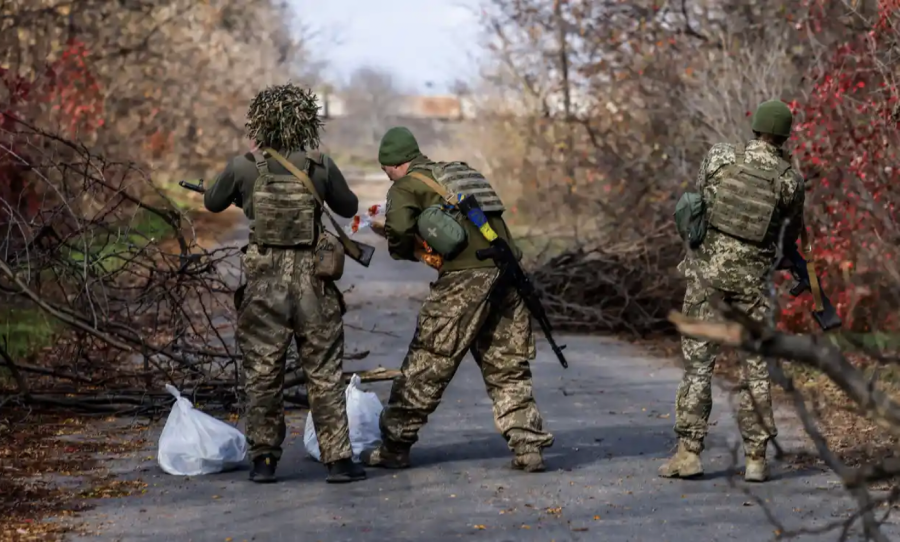U.S. alarmed by discussions of nuclear deployment in Russia-Ukraine war
November 5, 2022
The New York Times reported on Nov. 2 that in mid-October, the Pentagon alerted the Biden administration that they received military intelligence that Russia’s top senior military officials had discussions about using nuclear weapons.
Nuclear weapon discussions surfaced after Russia’s top military commander Gen. Valery Gerasimov repeated accusations to NATO nations that Ukraine’s military was building ‘dirty bombs’—United States intelligence did not find any evidence that President Zelenskyy’s military was preparing such devices.
A dirty bomb is a dynamite-like explosive wrapped in radiological waste, designed to circulate radioactive material throughout a designated location. These bombs are not capable of generating a nuclear-sized blast, despite the Kremlin’s assertion to manufacture these false allegations.
The Biden administration recognized that President Putin did not have a role in these meetings, but the U.S. interpreted these meetings as the Kremlin’s desperation and dissatisfaction with their military’s conquest. The United States did not report the specifications of Russia’s nuclear warfare procedures nor the specifications of Russia’s nuclear discussions and procedures. United States officials have made no indication that Russia is preparing to use such weapons. The lack of intelligence about Russia’s tactical nuclear weapons program and procedures remains compelling to Washington and the U.S. Department of Defense.
Tactical nuclear weapons are battlefield-designed nuclear military instruments deployed in limited-strike combat and are able to produce copious amounts of destruction. They are frequently operated as missiles, air-dropped bombs or even artillery shells. Tactical weapons cannot travel nearly as far as Intercontinental Ballistic Missiles (ICBMs), which are programmed for trans-oceanic combat.
Secretary of Defense Lloyd J. Austin III told reporters, “We are certainly concerned about escalation, and we have been so from the very beginning of this conflict,” and “if this happened, we have been very clear from the very beginning that you would see a very significant response from the international community.”
The Common Reporting Standard (CRS) reported that Russia’s stockpile of non-strategic nuclear weapons amassed 1,000 to 2,000 warheads. Nuclear warfare has not been implemented into any military’s battle plans in over 70 years. In early October 2022, President Joseph Biden remained doubtful that Putin would use nuclear weapons because of their limited use in Ukraine’s vast and scattered battlefields.
During an annual foreign policy conference on Oct. 27, outside Moscow, President Putin delivered his remarks that Moscow was battling the “Western Elites,” not the west itself, and repeated his claim that Ukraine was preparing to use Russia as a scapegoat to detonate dirty bombs. In this address, Putin denied that Moscow was arranging a plan to detonate nuclear weapons in Ukraine. He said, “We see no need for that… There is no point in that, neither political nor military.” Putin has single authority to deploy tactical nuclear weapons at his command, despite whether Kremlin officials resent his decisions. United States authorities remained alerted following Russia’s suffering from recent significant advances by the Ukrainian military’s resistance.
President Biden stated that even small-scale nuclear warfare could spiral out of control. He stated, “I don’t think there’s any such thing as the ability to easily [use] a tactical nuclear weapon and not end up with Armageddon,” per Reuters.
In the northern region of Ukraine, Kyiv’s regional head of military shared that they have prepared more than 400 “special warehouses” to prepare for a potential nuclear attack from Russia. Approximately 425 fallout shelters were constructed for a “worst-case scenario.” The A-bomb shelters are equipped with essential supplies to survive a nuclear fallout crisis. Ukrainian cities, towns and villages are all updating their evacuation routes and all emergency workers are receiving the proper training and protective gear for a nuclear scenario.
Following Russia’s missile attacks across Ukraine, the mayor of Kyiv Vitali Klitschko reported that 350,000 apartments lost electricity. Kyiv is preparing for even larger energy blackouts while simultaneously bracing for the harsh winter season. Power outages during Ukraine’s winter months can leave areas without heat for extended periods.
Oleksiy Kuleba, head of Kyiv’s regional military administration said, “For such a case, there are 750 stationary heating points in the Kyiv region” and, “These points are equipped with appropriate generators, there is food, certain water supplies. That is, these are shelters that will allow you to be warm and safe.”
During a press conference on Oct. 27, Defense Secretary Austin III shared, “That’s why we believe that it’s important to communicate with our allies and partners and also with our adversaries. As long as we have the channels of communication open, and we are able to communicate what’s important to us, then I think we have an opportunity to manage escalation.”
A nuclear strike would likely knock out communication services in Ukraine, so Kuleba’s next priority in preparation is communication. He has prepared fallout shelters with portable battery-powered radios.












